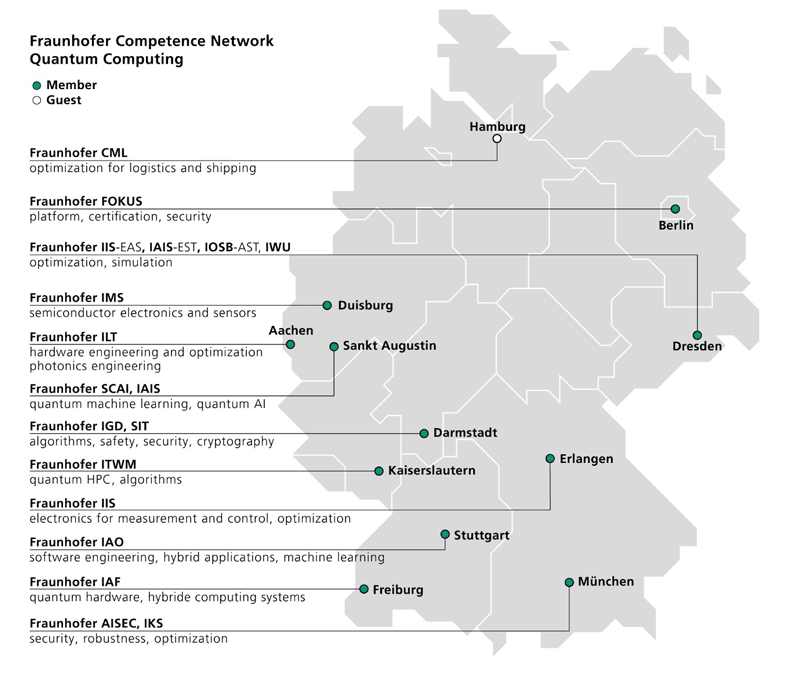by Kim Behlau and Hannah Venzl (Fraunhofer Competence Network Quantum Computing)
The Fraunhofer-Gesellschaft is embracing the challenge of using quantum computing in real-life industrial applications. The Fraunhofer Competence Network Quantum Computing was founded for this purpose; it provides a means for experts from various Fraunhofer Institutes to collaborate and network with partners from research and industry. Within this framework, the Fraunhofer-Gesellschaft provides access to the first quantum computer installed in Germany, the IBM Q System One in Ehningen.
Quantum computing has the potential to analyse complex systems in business and industry, unravel the complexity of molecular and chemical interactions, solve complex optimisation problems, and enhance the performance of artificial intelligence. The Fraunhofer-Gesellschaft has set itself the task of researching the multi-faceted potential offered by quantum computing for industrial and scientific applications and to this end has established a national network based on competence centres: The Fraunhofer Competence Network Quantum Computing [L1]. Each of the seven regional competence centres (comprising multiple Fraunhofer Institutes) has its own research focus within the area of quantum computing; the competence network pools this expertise to cover a wide range of topical issues and questions related to quantum computing (see Figure 1). The Competence Centre Quantum Computing Baden-Wuerttemberg, for example, addresses optimisation, quantum hardware, and hybrid computing systems; the Competence Centre in Rhineland-Palatinate focuses on quantum high-performance computing [L2]; the Bavarian on security and robustness in addition to platform development.

Figure 1: The Fraunhofer Competence Network Quantum Computing (comprised of multiple Fraunhofer Institutes) pools expertise to cover a wide range of topical issues and questions related to quantum computing.
The network cooperates closely with partners and customers from research and industry and addresses a broad range of application fields, including logistics, the chemical and pharmaceutical industries, the finance and energy sectors, materials science, IT security technology and much more.
In addition to the intensive networking of the German quantum computing ecosystem, the Fraunhofer Competence Network Quantum Computing has been seeking access to a quantum computing platform. Since January 2021, the Fraunhofer-Gesellschaft has had exclusive access to a quantum computer operated by IBM in Ehningen (Baden-Wuerttemberg) and the network is the primary point of contact for anyone wishing to use the quantum computer IBM Q System One. This is of enormous importance to actively shape the rapid developments in quantum computing – an achievement that is only possible if expertise is built up. In this context, the Fraunhofer-Gesellschaft acts as an enabler, as Fraunhofer not only provides its employees with access to the IBM Q System One but also provides access for partners from industry and research.
The IBM Quantum System One, a circuit-based quantum computer based on superconducting qubits (experimental system), has been optimised for stability and self-calibration to provide a reliable, high-quality quantum computer.
Technical data of the Ehningen system::
- 27 superconducting qubits
- Quantum volume of 32
- Coherence time ≈ 100 μs
- Single-qubit gate error ≈ 0.05%
- Two-qubit gate error ≈ 1%
- Time required for operating two-qubit gate ≈ 500 ns for CNOT.
With a power of 27 superconducting qubits and a quantum volume of 32, it is one of the most powerful quantum gate systems currently available. The IBM Q System One in Ehningen is operated on German soil, completely under German law and European data protection regulations. Both personal user data and project data remain in Germany at all times. The system in Ehningen is completely self-sufficient – there is no connection to the cloud systems operated in the US (users do, however, have access to these via a separate interface).
For industry and R&D organisations, the quantum computer can be used in joint projects. It can be used in funded collaborative projects with Fraunhofer, as well as in contract research within an industrial project. But partners can also access the infrastructure independently. For this purpose, an access and licence agreement is concluded with Fraunhofer, in which all details are regulated. After that, the corresponding partners can access the quantum computer (and the associated cloud systems) within a personal ticket system on monthly billing. The system is open to all research institutions and companies that have their headquarters in Germany and for European partners within in EU-funded projects (More details on “How do I use the quantum computer?”: L1). This is particularly interesting for anyone who wants to know whether quantum computing is suitable for their needs – in principle, this includes all industries from logistics to industrial manufacturing, energy and finance to the pharmaceutical industry. Currently, various top-class institutions from different fields are already using the IBM Q System One: Universities, non-university research institutions and industrial companies.
Within the framework of the Fraunhofer competence network Quantum Computing, many projects have already been started and more are constantly being added [L1]. Various projects want to test the limits and ascertain which problems can be addressed by real existing quantum computers. One of the projects funded in Baden-Wuerttemberg, “QuESt” [L3], is concerned with using and testing the IBM quantum computer for material simulations for electrochemical energy systems. This is thus an established field in which the research frontiers are to be extended by the quantum computer. Another practical project, “EFFEKTIF” [L3], deals with rapid and efficient error correction in the operation of system-relevant public infrastructure, such as for water and power supply or communications. While these structures can already be modelled, real-time simulation and problem solving is almost impossible to achieve due to the many factors involved. Therefore, these network structures are to represent and model quantum networks. The Fraunhofer ITWM is working on Quantum Algorithms in Material Simulation: Using acceleration and looking at the accuracy and errors of quantum Fourier transformations and their applicability to real problems [L2]. You can read more about this project in this issue (“Quantum Fourier Transformation in Industrial Applications”).
Links:
[L1] https://www.fraunhofer.de/en/quantumcomputing
[L2] https://www.itwm.fraunhofer.de/en/fields-of-application/quantum-computing.html
[L3] https://www.iaf.fraunhofer.de/en/networkers/KQC/projects.html
Please contact:
Hannah Venzl
Central Office of the Fraunhofer Competence Network Quantum Computing, Germany











